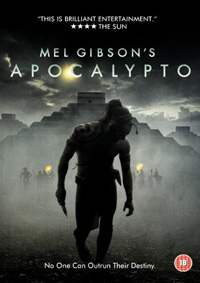 I have a feeling that if I knew anything at all about the Mayan people that I would probably be deeply, deeply annoyed by Mel Gibson’s Apocalypto. It has the feeling of authenticity – from the idyllic jungle village to the fantastically realised city through to the subtitled language – there has been a great deal of effort expended in making the viewer believe this version of Mayan history. But there are enough obvious sign posts to suggest that it is, underneath this veneer, a dreadful mash-up of times, places and ideas.
I have a feeling that if I knew anything at all about the Mayan people that I would probably be deeply, deeply annoyed by Mel Gibson’s Apocalypto. It has the feeling of authenticity – from the idyllic jungle village to the fantastically realised city through to the subtitled language – there has been a great deal of effort expended in making the viewer believe this version of Mayan history. But there are enough obvious sign posts to suggest that it is, underneath this veneer, a dreadful mash-up of times, places and ideas.
Even without being informed by historians who have studied this era that Apocalypto conflates and confuses two thousand years of history into one moment, it is obvious that there are large parts of this film that don’t ring true. Most glaringly, perhaps, is the fact that there could exist a people who live and hunt and are intimately tied to a jungle ecosystem but who appear entirely unaware that a vast, throbbing, noisy, dirty and all-consuming city is no more than three days walk from their village. The villager’s life is also just a little too idyllic. Their village – full of happy children, loving parents, unity and joy – paints a picture of a people without any hint of conflict, ambition or genuine human relationships. And then there is the problem of that city. It is, of course, intended to be going through an epoch-ending crisis, but there’s no sense that this kind of place could ever have been stable – the descent into brutality and desperation lacks any sense of counterpoint. Apocalypto’s Mayan rulers are not good people brought low but cruel tyrants revelling in blood and there’s only the sense of this bloody moment without any depth of history or sense of weight to their community.
But, outside the field of Mayan historians, does it matter that this film misrepresents the “true nature” of the Mayan people and their history?
The answer is, probably not.
Because the civilisation in Apocalypto was never meant to represent the “true” Mayan culture – whatever that might have looked like. The Mayans are used here in the same way science fiction and fantasy authors have used “alien” races to cast a light on the modern era. Gibson’s Mayans are no more a real people – and no more subtly drawn creations – that Swift’s Lilliputians or Plato’s Atlanteans.
Gibson calls his aliens Mayan – and not doubt those who understand or descend from that culture will find much to anger them – but he uses sights and sounds of their world to create culture shock and instil in his audience the “sense of wonder” that is at the intimate core of science fiction.
As the hero Jaguar Paw and his friends are dragged from their peaceful home and forced, wide-eyed and terrified, through the wild and blood-soaked city we are introduced to a people as distant and unlike us as any alien race ever to grace the screen. Apocalypto’s Mayan world is a violent and gory big-dumb-object designed to separate us from our mundane expectations.
The process of constructing the alien, at least in decent science fiction, should not stop at battering our senses with amazing images. The experience of the alien should reflect on some aspects of our human nature – it should teach us something about ourselves. So it is that, when we look a little deeper behind the impressive visuals, the dramatic chases and strong emotional sympathy that Gibson creates for his protagonist, we see revealed the essentially conservative “moral” of this story.
The villain in Apocalypto is not Zero Wolf (Raoul Trujillo – who is fantastic) or the hateful Snake Ink (Rodolfo Palacios) but the idea of civilisation itself.
Everything evil and truly dangerous in Apocalypto comes from attempts to civilise man. The Mayan world is in crisis because of a plague – smallpox brought to the “New World” by Europeans – which, in turn, has caused the civilisation built in the city to collapse, the decadent rulers to turn on their people and to reveal in themselves the very vilest of human nature.
Having escaped all that, defeated his foes and returned to his village, Jaguar Paw is for a final time offered the opportunity to embrace civilisation. His response is to turn to the jungle in search of a new beginning – a new Eden in the jungle.
Ultimately, then, Apocalypto seeks to convince us that happiness, security and decency can only be found by turning our back on the advanced world and returning to nature, or rather, more specifically, returning to an agrarian idyll where everyone knows their place and authority is not questioned.
Philosophical qualms should not, however, stop you seeing this film. It is, by some considerable margin, Gibson’s most stunning outing as a director and though viewers will need a strong stomach (the full-frontal nature of the violence really cannot be overstated) it is a truly epic piece of film making with extraordinary set-pieces and moments of eye-popping spectacle.
(Originally published in Matrix 183, Jan/Feb 2007)